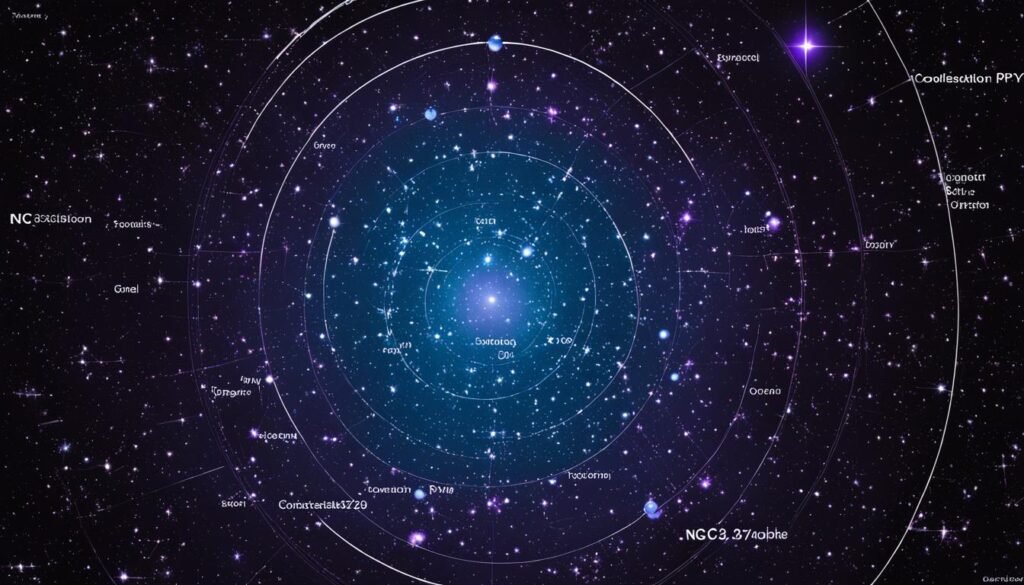| Genitive | |
| Abbreviation | |
| Pronunciation | |
| Main Stars | |
| Brightest Star | |
| Right Ascension | |
| Declination | |
| Sq. Deg. Area | |
| Crosses Meridian | |
| Visible Lat. Range |
If you’ve ever looked up at the night sky from the Southern Hemisphere, you might have come across the Pyxis constellation, a less celebrated but fascinating star pattern. Pyxis constellation information uncovers that this subtle celestial feature is a mariner’s guide, pointing towards the rich history of naval exploration. As you delve into Pyxis constellation facts, you will find that it is an essential fragment of sky lore, providing not just navigational aid but also a glimpse into the storied past of astronomy.
No mythological legends directly tie to Pyxis, as this constellation wasn’t among the ancient Greeks’ starry diagrams. However, its story begins with the influential work of French astronomer Nicolas Louis de Lacaille, who categorized the constellations during his astronomical endeavors in the 18th century. Through its modest but significant existence, you’ll grasp the broader narrative of the constellation Pyxis and its role in the panoramic tapestry of the universe.
Key Takeaways
- Discover the origins of the constellation Pyxis, initially named Pyxis Nautica by Nicolas Louis de Lacaille.
- Learn about the brightest star in Pyxis, Alpha Pyxidis, and its role in the constellation’s structure.
- Explore less-known facts about Pyxis, such as the absence of Messier objects, enhancing its celestial allure.
- Uncover the constellation’s association with maritime history and celestial navigation.
- Gain insight into why Pyxis is not a part of the mythological Argo Navis, contrary to some beliefs.
- Find out how Pyxis connects with its neighboring constellations – Antlia, Hydra, Puppis, and Vela.
- Understand the significance of the International Astronomical Union’s (IAU) designation of Pyxis and its three-letter abbreviation ‘Pyx’.
Unveiling the Mysteries of Constellation Pyxis
The celestial tapestry of the night sky holds many wonders, and among them is the Pyxis constellation, a constellation rich in navigation history and astronomical significance. Situated away from the ecliptic plane, it is relatively free from the glare of the Sun, allowing its stars to be observed even with moderate light pollution. While it may not boast the fame of its more storied neighbors, the stories of navigation that accompany Pyxis add a depth of character to this celestial feature.
Origins and the Mariner’s Compass
With its earliest records dating back to the meticulous observations by Nicolas Louis de Lacaille, the Pyxis constellation history begins in the 18th century. Originally named after the mariner’s compass, which has guided countless seafarers through the treacherous oceans, Pyxis marks a point of interest for those keen on the celestial means of navigation. Its significance lies not in ancient mythologies but in the practical application of celestial navigation, reflecting humanity’s enduring quest to conquer the seas.
Exploring the Stars of Pyxis
Despite its humble appearance, the stars of Pyxis are a gateway to understanding the heavens. Due to the scarcity of bright stellar bodies and named stars within its borders, obtaining a Pyxis star map is crucial for any amateur astronomer wishing to pinpoint this constellation’s location. The map not only provides a visual guide to identifying Pyxis but also offers insight into the constellation’s spatial relationship with its surrounding celestial entities.
Celestial Navigation and Pyxis’ Role
The importance of the Pyxis constellation location extends well beyond simple stargazing. Mariners of old relied heavily on the constellations for navigation, and Pyxis, representing the compass, played a vital role in their oceanic journeys. This constellation’s place in the sky served as one of the many celestial landmarks used to determine direction and position on the open seas, helping to guide explorers and traders to new and distant shores throughout history.
The Astronomical History of Pyxis
The constellation known as Pyxis is steeped in rich maritime history. This particular group of stars, first cataloged under the name ‘Pixis Nautica’ by Nicolas Louis de Lacaille in 1763, serves as a celestial nod to the navigational tools that were crucial to sailors of old. You can visualize the far-reaching influence of Pyxis in maritime navigation through its symbolization of magnetic compasses, instrumental for sea voyages prior to modern technology. Unlike its astronomical neighbor Circinus, which stands for a draftsman’s compass, Pyxis distinctly represents the mariner’s compass, with its history inextricably linked to the vast ocean and exploration.
When Lacaille broke up the enormous Argo Navis constellation, he assigned parts of it to new constellations Carina, Puppis, and Vela, all while designating Pyxis as an independent constellation. Subsequently, the notable 19th-century astronomer John Herschel suggested renaming it to ‘Malus,’ to symbolize the mast of a ship. However, this proposal did not solidify, and the International Astronomical Union (IAU) ultimately recognized Pyxis as one of the 88 modern constellations. In doing so, the IAU preserved the significant historical link with the navigational heritage that Pyxis constellation represents.
For the constellation enthusiasts and night sky explorers, Pyxis constellation facts offer a gateway to understanding the celestial landscapes where history and astronomy intertwine. Discovering Pyxis constellation history enables you to appreciate not just the beauty of the stars but also the development of cartography and navigation that was essential to ancient mariners and remains relevant in present astronomical studies.
| Feature | Historical Significance |
|---|---|
| Lacaille’s Cataloging | 1763, named ‘Pixis Nautica’ |
| Name Simplification | Evolved to simply ‘Pyxis’ over time |
| Mariner’s Compass | Symbolizes navigational reliance at sea |
| IAU Designation | Recognized as one of the 88 modern constellations |
Awareness of the Pyxis constellation and its place in the cosmic ocean can enrich your understanding of both the historical and contemporary skies. The section below captures the essence of Pyxis in a visually stunning manner, emphasizing the splendid view that has guided seafarers throughout the ages.

A Tour of the Pyxis Stars
As you embark on a celestial journey through the Pyxis constellation, you’ll encounter a remarkable tapestry of stars, each contributing its own story to the fabric of the night sky. Distinct among these are the luminaries known as Pyxis stars, which include some of the most fascinating stellar phenomena in the cosmos. Notably, the brilliance of Alpha Pyxidis guides the way as the constellation’s brightest point.
Alpha Pyxidis: The Brightest Beacon
Alpha Pyxidis, the jewel in the Pyxis constellation, is a Beta Cephei variable star that demands attention with its stellar magnitude of 3.68. At a significant distance of 880 light-years from Earth, this star’s radiance is a beacon that pierces through the vastness of space to greet us with its light.
Stellar Companions: Binary and Multiple Star Systems
Delving deeper into the heart of Pyxis, we uncover the complexity brought forth by binary and multiple star systems. Stars like Beta Pyxidis and Gamma Pyxidis exemplify the binary connections, weaving together the narrative of cosmic relationships. These star systems reveal the richness of Pyxis, letting us explore the intricate dance of gravity-bound stellar partners.
The Pulsating Heart: Variable Stars within Pyxis
Variable stars also play a critical role in the celestial ballet of Pyxis. The recurrent nova T Pyxidis, particularly, stands as a testament to the dynamic nature of the cosmos. Known for its dramatic brightening episodes, T Pyxidis brings a pulsating heartbeat to the otherwise tranquil backdrop of the night sky.
Below is a table detailing key characteristics of the prominent stars that embellish the Pyxis constellation:
| Star Name | Star Type | Magnitude | Distance (light years) | Notes |
|---|---|---|---|---|
| Alpha Pyxidis | Beta Cephei variable | 3.68 | 880 | Brightest star in Pyxis |
| Beta Pyxidis | Binary star system | 3.97 | 420 | Comprised of two stars orbiting each other |
| Gamma Pyxidis | Binary star system | 4.01 | 207 | Easily observable with small telescopes |
| T Pyxidis | Recurrent nova | 6.4 – 15.5 (variable) | 4,783 | Periodically erupts increasing in brightness |
Navigating Deep Sky Wonders in Pyxis Constellation
As you journey through the cosmos, the Pyxis constellation stars beckon with an array of deep sky marvels. Within this celestial haven, you’ll encounter the vibrant planetary nebula NGC 2818, a spectacular testament to the life cycle of stars. Gaze upon the open star cluster, NGC 2627, a gravitational ballet displaying the harmony within the chaos of the universe. Not to be outshone, the NGC 2613 barred spiral galaxy offers a glimpse into a structure akin to our own Milky Way. These Deep sky objects in Pyxis stand as silent witnesses to the grandeur and expanse of our night sky.

Engage with the heavenly bodies of Pyxis through the lens of your telescope and let the following table guide you to the constellation’s most luminous spectacles:
| Object Name | Type | Description | Observation Tips |
|---|---|---|---|
| NGC 2818 | Planetary Nebula | A stunning array of colors marking the remnants of a star similar to our Sun. | Look for the complex gas structures; best viewed through a medium-to-large telescope. |
| NGC 2627 | Open Star Cluster | A loosely knit group of stars, showcasing stellar formation and evolution. | Suitable for small telescopes; observe the differing star magnitudes and colors. |
| NGC 2613 | Barred Spiral Galaxy | An impressive galaxy that mirrors the structure of the Milky Way. | Use high magnification to distinguish the bar structure; a larger telescope enhances the view. |
Pyxis, the nautical guiding star system, not only charts a course through the seas but also offers a celestial voyage through the night. Remember, each visit to these celestial phenomena enhances your appreciation of the universe’s wonders. Your odyssey among the Deep sky objects in Pyxis awaits!
Pyxis Constellation Through the Ages: Mapping and Mythology
As you delve into the night sky, the Pyxis constellation serves as a beacon within the sprawling celestial seas. Its history is a testament to the ingenuity and curiosity of navigators and astronomers, punctuated by compelling transformations that reflect mankind’s journey in understanding the heavens. The constellation’s story is a fusion of practical necessity and stellar beauty, charting a course from antiquity to modern-day astronomy.
From Argo Navis to Pyxis: The Evolution of Constellations
The ancient form of Pyxis was part of the larger construct, Argo Navis, an homage to the ship that carried Jason and the Argonauts in Greek mythology. This grand constellation, however, was divided for navigational practicality, giving rise to Pyxis. Your exploration of star maps of the Pyxis constellation, shedding light on how early sea voyagers relied upon these celestial points to guide their passage across vast, uncharted waters.
The Celestial Seas: Pyxis in the Heavenly Waters Family
Joining the likes of other nautical constellations, Pyxis proudly anchors itself within the Heavenly Waters family of constellations. This group binds together patterns that symbolize water or sea exploration, with Pyxis’ stars Alpha, Beta, and Gamma Pyxidis securing its place in these mythic oceanic realms. The Pyxis constellation location finds its presence resonating within the collective narrative of the seas, emphasizing humankind’s intrinsic connection to the waters of the world.
The IAU and the Modern View of Pyxis
Vestiges of historical navigational aids persist as the International Astronomical Union (IAU) has formalized the boundaries and configuration of Pyxis, perpetuating its significance in the sky. The IAU’s official Pyxis constellation map equips you, akin to a celestial cartographer, with the means to journey through the stars. This modern fabric of Pyxis constellation information binds the old with the new, ensuring the mariner’s compass continues to kindle the sense of wonder and exploration in humanity.
FAQ
What does the constellation Pyxis represent?
The constellation Pyxis represents a mariner’s compass, used by sailors to navigate the seas. It symbolizes the instrument’s role in maritime history and celestial navigation.
Who introduced the constellation Pyxis and when?
The constellation Pyxis was introduced by French astronomer Nicolas Louis de Lacaille during his 18th-century expedition to the southern hemisphere, specifically after his observations made at the Cape of Good Hope in the mid-1750s. It was first cataloged as Pyxis Nautica before being shortened to Pyxis.
Where is the constellation Pyxis located in the sky?
Constellation Pyxis is located in the southern sky. It is surrounded by the constellations Antlia, Hydra, Puppis, and Vela and can be best viewed in the spring months from southern latitudes.
Did Pyxis originally belong to another constellation?
No, Pyxis was not originally part of another constellation but is sometimes mistakenly associated with the Greek constellation Argo Navis. While it lies close to the parts that once formed Argo Navis (Carina, Puppis, and Vela), it was defined separately by Lacaille to represent the mariner’s compass.
What are the main stars that make up the Pyxis constellation?
The main stars that make up the constellation Pyxis are Alpha Pyxidis, the brightest star in the constellation, along with other notable stars such as Beta and Gamma Pyxidis.
Are there any Messier objects in Pyxis?
No, there are no Messier objects in the constellation Pyxis. However, the constellation does contain several other deep sky objects, including the planetary nebula NGC 2818 and galaxies such as NGC 2613 which are of interest to astronomers.
What does Alpha Pyxidis signify within the Pyxis constellation?
Alpha Pyxidis is the brightest star in the constellation Pyxis and is a Beta Cephei variable star. It stands as the most luminous beacon for the constellation and plays a significant role in its identification.
Can you tell me more about the deep sky objects found in Pyxis?
Pyxis is home to a variety of deep sky objects, including the beautiful planetary nebula NGC 2818, the open star cluster NGC 2627, and the barred spiral galaxy NGC 2613. These celestial objects provide rich opportunities for observation and study of the universe’s complexities.
What is the history behind the naming of Pyxis?
Pyxis derives its name from the original term ‘Pyxis Nautica’ used by its founder, Nicolas Louis de Lacaille. The name, which refers to the mariner’s compass, was later simplified to ‘Pyxis.’ Despite some suggestions for changing its name, such as to ‘Malus’ by John Herschel, the IAU formalized ‘Pyxis’ as its official name in the 20th century.
What is the significance of Pyxis within the Heavenly Waters family of constellations?
Pyxis is a part of the Heavenly Waters family of constellations, a group of constellations associated with water or maritime themes. Pyxis contributes to the narrative of these constellations with its representation of the mariner’s compass, an essential tool for navigation across the world’s oceans.






